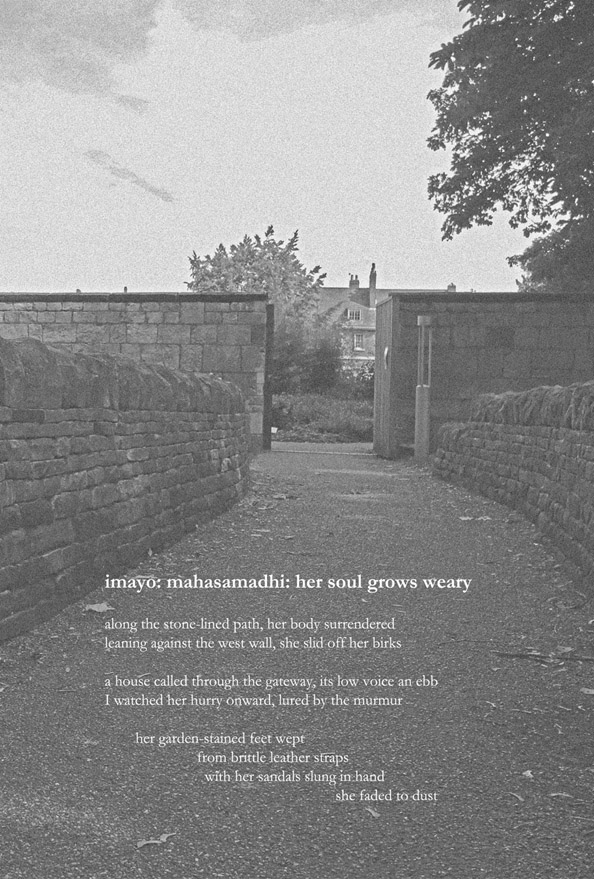
imayo: mahasamadhi: her soul grows weary

Koss
3 Questions for Koss
What was your process for creating this work? What is the significance of the form/genre/medium(s) you chose for this work? What is the significance of this work to you?
Imayo
The Imayo and path was conceived of through a meditation on a photo sequence. Only days before her death, I took some photos of Max on the path and some without her. After her death, I reviewed the photos and in the sequence, I started to feel a story. The Imayo seemed to fall into that “absence space,” sitting in for her, and provided a childish reprieve from thinking about the death process and negotiating the physical loss of her. The details were what I perceived in her person, before and after. I wrote it with the photo in mind, its shell . . . I altered the photo in Photoshop to further distance myself from the death story, converting to monochrome. I believe an “aura” remains within all of this distancing.
Other Photos
Most of the photos were from the last days of Max’s life, but she appears as absence. She was next to me when I took most of them. The angel, an exception, was from a cemetery where Max never stepped. I altered the angel to a blurry monochrome in Photoshop. She is cheap, inauthentic—and sublime all at once. As if one could believe . . . Without a place to grieve Max, I made my own nearby; an ancient cemetery full of cheap statues, broken mossy stones, and ghosts. This and other small-town photography excursions were my grief meditations during a period in which there were no words.
Significance
Photos were mostly real life things that took on a larger meaning after Max’s death. Photography/shooting serves as a sort of window between worlds—the illusion of physicality. By their nature they are static, a pause or a silence.
Poems
I Was Told There’d Be No Service
This poem rattled around a long time as raw language and fragments, then it spilled into a really long poem with a blocky, massive rant about how nothing can fix death. It went through many renditions/cuts until arriving at its current somber, distilled form, a stark re-fabrication of an event not seen. Of course, she is, again, absent, but present in how people choose to represent her. And author is absence. The process was really about writing out of and away from things.
I Still Talk to You Two Years Later
This piece unfolded in real time as I contemplated my surroundings, close and far, on a quiet Saturday. I don’t know if I heard planes, or imagined them, but one did sound as I wrote the last line. More so, than many poems, I’d call it meditative, and zuihitsuish, only with fairly tight curves. It’s hard to think of language as meditative, but the zuihitsu lends itself to tapping into the less conscious zones. It’s epistolary, as are a lot of the poems in One for Sorrow. The whole body of work started out as a journal, also epistolary (letters to Max).
Significance
This work and others from One for Sorrow was my lifeline after the loss of Max and other losses that immediately followed, including COVID. My grief meditation and a memorial to Max.
Find work by Koss in Hobart, Cincinnati Review, Spillway, Diode Poetry, Rogue Agent, Five Points, Spoon River, Chiron, Lumiere Review, Kissing Dynamite Poetry, Prelude, Amethyst Review, and many others. They also have work in Best Small Fictions 2020 and work forthcoming in Kissing Dynamite’s Punk Anthology. Read more Koss at https://koss-works.com.